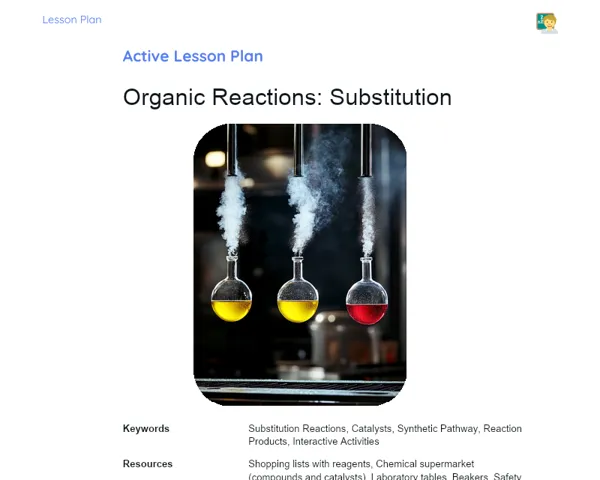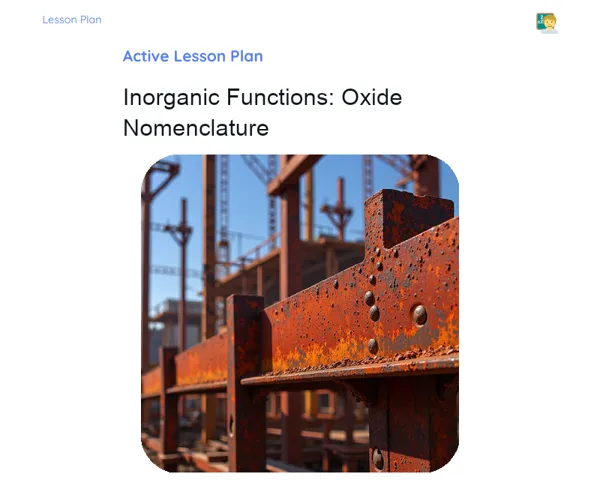Lesson Plan | Lesson Plan Tradisional | Organic Functions: Phenol
| Keywords | Phenols, Hydroxyl, Aromatic Ring, Physical Properties, Acidity, Reactivity, Nitration, Halogenation, Applications in Everyday Life, Salicylic Acid, Disinfectants, Pharmaceutical Industry |
| Resources | Whiteboard and markers, Multimedia projector, Presentation slides, Molecular model of phenol (C6H5OH), Printed examples of phenols, Note-taking materials for students (notebooks, pens), Handouts or textbooks on organic chemistry |
Objectives
Duration: (10 - 15 minutes)
This stage aims to guide students on what they will learn during the lesson. By clearly outlining the main objectives, students will understand the knowledge and skills they are expected to acquire by the end of the session, fostering focus and enhancing effective learning.
Objectives Utama:
1. Define phenols and describe their fundamental chemical structures.
2. Explain the properties and characteristics of phenols, including their solubility, acidity, and reactivity.
3. Identify common examples of phenols and their practical applications in daily life.
Introduction
Duration: (10 - 15 minutes)
This stage aims to equip students with contextual information regarding the lesson's theme, establishing a strong foundation for understanding phenols. By sharing initial details and intriguing facts, it aims to capture students' interest and prepare them for a more profound exploration of the subject. This context is essential for helping students link theoretical concepts to real-world applications.
Did you know?
Phenols have significant roles in the manufacturing of everyday products. For example, salicylic acid, a specific type of phenol, is a vital ingredient in many skincare products like acne creams. Additionally, phenols are utilized in the creation of medications and disinfectants, showcasing their importance in public health and the pharmaceutical sector.
Contextualization
To kick off the lesson on phenols, highlight that phenols are organic compounds featuring a hydroxyl (-OH) group attached directly to an aromatic ring. They are crucial in organic chemistry due to their distinct properties and diverse applications. Illustrate the phenol molecule (C6H5OH) on the board to demonstrate its basic chemical structure. Stress that the aromatic ring gives these compounds unique characteristics, setting them apart from simple alcohols.
Concepts
Duration: (50 - 60 minutes)
This stage seeks to deepen students' understanding of phenols, encompassing their definitions, properties, acidity, reactivity, and practical applications. By offering detailed explanations and relevant examples, it aims to reinforce students' theoretical comprehension and prepare them to apply this knowledge in practical contexts. The proposed questions will help consolidate the content learned and encourage critical thinking.
Relevant Topics
1. Definition and Structure of Phenols: Explain that phenols are organic compounds characterized by a hydroxyl (-OH) group directly linked to an aromatic ring. Present the chemical structure of phenol (C6H5OH) and underscore the differences between phenols and alcohols.
2. Physical Properties of Phenols: Elucidate the physical properties of phenols, such as their state, melting and boiling points, and solubility in water and other solvents. Highlight the impact of the aromatic ring on these properties.
3. Acidity of Phenols: Clarify the acidity of phenols in comparison to alcohols. Introduce the concept of acid dissociation constant (Ka) and demonstrate how the aromatic ring stabilizes the phenoxide ion, thereby increasing acidity.
4. Reactivity of Phenols: Discuss the typical chemical reactions phenols undergo, including nitration and halogenation. Explain how the hydroxyl group affects the chemical reactivity of phenols.
5. Applications of Phenols: Provide examples of phenols in everyday life, such as salicylic acid in skincare and medications. Discuss their significance in the pharmaceutical industry and public health.
To Reinforce Learning
1. Explain why phenols are more acidic than alcohols.
2. Describe the primary chemical reactions that phenols can undergo and their significance.
3. Provide examples of practical applications of phenols in daily life and elaborate on their importance.
Feedback
Duration: (20 - 25 minutes)
This stage is designed to review and consolidate the knowledge students have gained during the lesson. Through discussions on the posed questions and engaging students in reflective inquiries, it aims to fortify their theoretical foundations and encourage practical application of the content learned. This final review also grants teachers an opportunity to assess students' understanding and clear any lingering doubts, ensuring a comprehensive and effective learning experience.
Diskusi Concepts
1. Explain why phenols are more acidic than alcohols: The higher acidity of phenols arises from the resonance stabilization of the phenoxide ion (C6H5O-). When phenol loses a proton (H+), the resultant ion is stabilized by the delocalization of negative charge over the aromatic ring. This resonance effect is not seen in alcohols, where the alkoxide ion (RO-) lacks such stabilization. Additionally, the electronegativity of the aromatic ring also contributes to the enhanced acidity of phenols. 2. Describe the main chemical reactions that phenols can undergo and their importance: Phenols can participate in various chemical reactions, including nitration, halogenation, and esterification. During nitration, a nitro group (-NO2) is attached to the aromatic ring, which is relevant for synthesizing explosives and dyes. In halogenation, halogen atoms (like Cl or Br) are affixed to the ring, potentially altering the physical and chemical properties of the compound. Esterification, involving reactions with carboxylic acids or their derivatives, results in phenolic esters, which find applications in perfumes and flavoring agents. 3. Give examples of practical applications of phenols in everyday life and justify their importance: A common example is salicylic acid, employed in acne treatments and as a precursor for synthesizing aspirin. Phenols are also critical as disinfectants due to their antimicrobial properties. In the pharmaceutical realm, phenols are vital in synthesizing various medications. Moreover, compounds such as bisphenol A are used in making plastics and resins, showcasing their industrial significance.
Engaging Students
1. Encourage students to discuss how the chemical structure of phenols influences their physical and chemical properties. 2. Have students compare the acidity of phenols with that of other organic compounds and articulate their thoughts. 3. Request examples of everyday products that contain phenols and deliberate on their relevance. 4. Motivate students to reflect on the significance of phenols in the pharmaceutical sector and other technological domains. 5. Ask students to consider other chemical reactions phenols might participate in and their applications in industry.
Conclusion
Duration: (10 - 15 minutes)
This stage aims to recap and reinforce the primary points discussed throughout the lesson, bolstering students' grasp of the topic. By connecting theoretical concepts to practical applications and emphasizing the significance of phenols in daily life, it seeks to ensure students appreciate the relevance of the knowledge acquired and are ready to apply it in future situations.
Summary
['Phenols are defined as organic compounds with a hydroxyl group directly attached to an aromatic ring.', 'Physical properties of phenols include their physical state, melting and boiling points, and solubility.', "Phenols' acidity in comparison to alcohols is highlighted by the stabilization of the phenoxide ion.", 'The reactivity of phenols and the key chemical reactions they can undergo, such as nitration and halogenation.', 'Practical applications of phenols in daily life, including skincare products, medications, and disinfectants.']
Connection
The lesson linked theory with practice by showcasing tangible examples of phenols found in everyday products and the pharmaceutical industry. Comprehensive explanations of the chemical reactions and properties of phenols enabled students to understand their applications across diverse technological and public health sectors.
Theme Relevance
Phenols play a vital role in our daily lives through their use in personal care products, medications, and disinfectants. For instance, salicylic acid, a phenol, is popularly used in acne treatments and for aspirin synthesis. These compounds also have critical industrial applications, serving in the production of plastics and resins.



